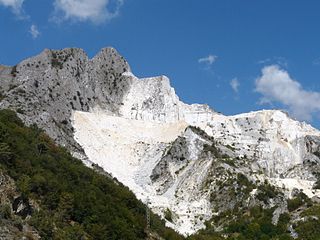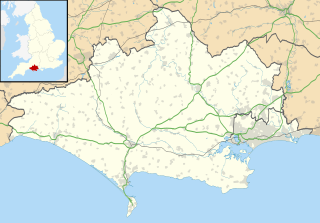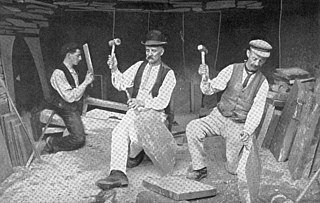
A quarry is a type of open-pit mine in which dimension stone, rock, construction aggregate, riprap, sand, gravel, or slate is excavated from the ground.

Blaenau Ffestiniog is a historic mining town in Wales, in the historic county of Merionethshire, although now part of the unitary authority of Gwynedd. The population of the community of Ffestiniog was 4,875 according to the 2011 census, including the nearby village of Llan Ffestiniog, which makes it the fourth most populous community in Gwynedd, after Bangor, Caernarfon, and Llandeiniolen. Llan Ffestiniog's population of 864 puts the population of Blaenau itself at around 4,000. Blaenau Ffestiniog was at one time the second largest town in North Wales, behind only Wrexham. After reaching 12,000 at the peak development of the slate industry, the population fell with the decline in the demand for its slate. Today the town relies heavily on tourists, who come for attractions that include the nearby Ffestiniog Railway and Llechwedd Slate Caverns.

Portland stone is a limestone from the Tithonian stage of the Jurassic period quarried on the Isle of Portland, Dorset. The quarries consist of beds of white-grey limestone separated by chert beds. It has been used extensively as a building stone throughout the British Isles, notably in major public buildings in London such as St Paul's Cathedral and Buckingham Palace. Portland stone is also exported to many countries—being used for example in the United Nations headquarters building in New York City.

Pipestone National Monument is located in southwestern Minnesota, just north of the city of Pipestone, Minnesota. It is located along the highways of U.S. Route 75, Minnesota State Highway 23 and Minnesota State Highway 30.

Alibates Flint Quarries National Monument is a U.S. National Monument in the State of Texas. For thousands of years, people came to the red bluffs above the Canadian River for flint, vital to their existence. Demand for the high quality, rainbow-hued flint is reflected in the distribution of Alibates Flint through the Great Plains and beyond. Indians of the Ice Age Clovis Culture used Alibates flint for spear points to hunt the Imperial Mammoth before the Great Lakes were formed. The flint usually lies just below the surface at ridge level in a layer up to six feet thick. The quarry pits were not very large, between 5 and 25 feet wide and 4 to 7 feet deep. Many of these quarries were exploited by the Antelope Creek people, of the Panhandle culture, between 1200 and 1450. The stone-slabbed, multi-room houses built by the Antelope Creek people have long been of interest to the public and studied by archaeologists. Today this area is protected by the U.S. National Park Service and can only be viewed by ranger-led guided tours, which must be reserved in advance.

Tophill is a gently sloping area of land on the Isle of Portland in Dorset, England. Rising from sea level at Portland Bill to 151 metres (495 ft) near HMP The Verne at its northern end, Tophill contains the villages of Easton, Weston, Southwell, the Grove and Wakeham.
The lower northern end of the island is called Underhill.
Purbeck Marble is a fossiliferous limestone found in the Isle of Purbeck, a peninsula in south-east Dorset, England. It is a variety of Purbeck stone that has been quarried since at least Roman times as a decorative building stone, but this industry is no longer active.
Effigia was an archosaur that lived in what is now New Mexico, south-western USA. The 2 meter (6 ft) fossil was collected by Edwin H. Colbert in blocks of rock from the Ghost Ranch Quarry, which were excavated in 1947 and 1948. However, Colbert did not think any large vertebrates besides basal theropod dinosaurs were present in the quarry and as such did not even open the jackets of most of the blocks that were returned to the American Museum of Natural History.

The existence of a slate industry in Wales is attested since the Roman period, when slate was used to roof the fort at Segontium, now Caernarfon. The slate industry grew slowly until the early 18th century, then expanded rapidly until the late 19th century, at which time the most important slate producing areas were in northwest Wales, including the Penrhyn Quarry near Bethesda, the Dinorwic Quarry near Llanberis, the Nantlle Valley quarries, and Blaenau Ffestiniog, where the slate was mined rather than quarried. Penrhyn and Dinorwig were the two largest slate quarries in the world, and the Oakeley mine at Blaenau Ffestiniog was the largest slate mine in the world. Slate is mainly used for roofing, but is also produced as thicker slab for a variety of uses including flooring, worktops and headstones.

The Quincy Quarries in Quincy, Massachusetts, produced granite for over a century and were the site of the Granite Railway—often credited as being the first railroad in the United States. A 22-acre (8.9 ha) section of the former quarries is owned and operated by the Massachusetts Department of Conservation and Recreation as a public recreation area.
Purbeck stone refers to building stone taken from a series of limestone beds found in the Upper Jurassic to Lower Cretaceous Purbeck Group, found on the Isle of Purbeck, Dorset in southern England. The best known variety of this stone is Purbeck Marble. The stone has been quarried since at least Roman times up to the present day.

The Blue Lias is a geologic formation in southern, eastern and western England and parts of South Wales, part of the Lias Group. The Blue Lias consists of a sequence of limestone and shale layers, laid down in latest Triassic and early Jurassic times, between 195 and 200 million years ago. The Blue Lias is famous for its fossils, especially ammonites.

Hallelujah Bay is a bay located on the west side of the Isle of Portland, Dorset, England. The bay is situated below West Weares, with Clay Ope, Blacknor Point and Mutton Cove further south. Near the cove is a large mound of rock and earth beneath the clifftops known locally as the Green Hump.

King Barrow Quarry is a disused site of former 19th century stone quarries on the Isle of Portland, Dorset, England. It is located in the north-east corner of Tophill. The quarry, now a Dorset Wildlife Trust nature reserve, covers 12.2 hectares. Both King Barrow and the nearby Tout Quarry make up the Dorset Wildlife Trust's Portland Quarries Nature Park. Portland also has two butterfly reserves; Broadcroft Quarry and Perryfield Quarry.
The Lulworth Formation is a geologic formation in England. It dates from the late Tithonian to the mid Berriasian. It is a subunit of the Purbeck Group. It consists of three members, which are in ascending order, the Mupe Member, the Ridgway Member, and the Warbarrow Tout Member. The Mupe Member is typically 11 to 16 m thick and largely consists of marls and micrites with interbeds of calcareous mudstone. The Ridgeway Member is about 3 to 7 m thick and consists of in its western portion carbonaceous muds, marls and micrites, in the east the muds are replaced by micritic limestone. The Warbarrow Tout Member is 17 to 39 m thick and consists of limestone at the base and micrite and mudstone for the rest of the sequence, this member is the primary source of the vertebrate fossils within the formation.

Stone Quarry Hill is a mountain in the Central New York region of New York. It is located northwest of East Worcester, New York.













